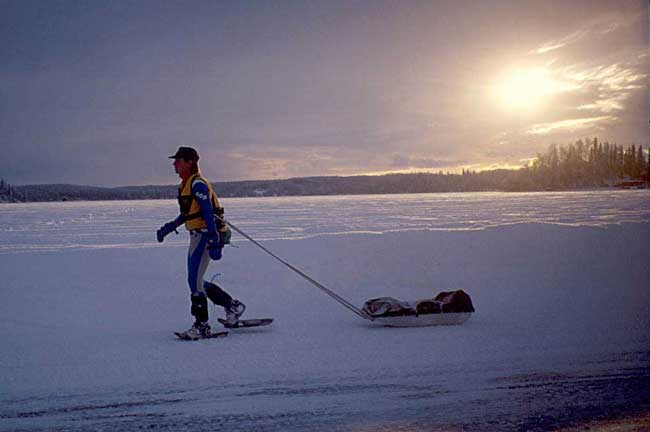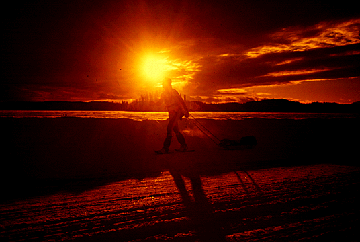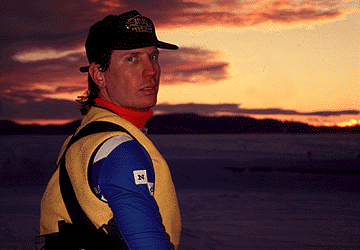|
|
Have Snowshoes, Will Travel: A Report From
the 1996 Iditasport 100-Mile Snowshoe Race
By Chris Kostman
Originally published in Oui, 1996, Fitness Plus, Vol. 7, No.9, September 1996, and ULTRA Cycling, Vol.5, No.1, March 1996
More Iditasport articles
"Pain is temporary, but failure lasts forever."
It was eight degrees out and I was 22 hours and 80 miles into a 100 mile snowshoe race through the wilderness on Alaska's Iditarod Trail. Pulling my food, water, clothing, and mandatory survival gear in a sled behind me up the long, rolling hills made me feel like a pack animal. My long stride was down to baby steps and no movement was possible without serious pain from hip to big toe. But my pain mantra, adopted more as a joke than seriously, kept me going. "Pain is temporary, but failure lasts forever." The stupid machoness of such a saying made me smile through the pain.
On one particular hill my left hip flexor shut down and every single step required a very audible grunt or snarl to make my left leg lift. I felt like Jack Nicholson in "The Shining" as I dragged my left leg up the steep, icy grade. Quickly my pain mantra was replaced with Nicholson's "all work and no play makes Jack a dull boy." The smile was fading a bit...
It's the price I sometimes pay for adventure.

ALASKA'S UNDOG RACE
This particular adventure is known as the Iditasport Human-Powered Ultra Race. Competitors use mountain bikes, skis, running shoes, or snowshoes to "traverse land more home to moose than man." Bikers and skiers do a two hundred mile out-and-back course, while those on foot and snowshoe are flown out to the furthest point and run the 100 miles back on the same course to the bike and ski start/finish line. Although the course is made up of entirely frozen and snow-laden rivers, lakes, swamps, and forests, varying weather conditions each year make for a different race which can favor one mode of transportation over another. Usually bikers rule the 200 mile race, while runners beat the snowshoers for the 100 miles. But occasionally the snow is soft enough that they're left straggling while the skiers and snowshoers dominate.
I'd done the race five times prior to this edition and had pretty much seen it all: moose, wolves, blood all over the trail from wolves attacking a moose, frigid, open water where the trail was supposed to be, twenty below temperatures, snow storms, and fellow competitors lost, frost-bitten, hypothermic, in tears, and/or with knees swollen up like grapefruit. I'd done the bike race three times (in 88, 89, and 91), but switched to snowshoes after being frustrated by soft snow forcing us bikers to push our bikes for up to 65 of the 200 miles. And although I had found snowshoeing to be much harder, more painful, and ultimately more dangerous than biking in this race, I was now back for my third entry in the snowshoe division.
The snowshoe division has become an intensely competitive race in recent years (one year there was even a sprint finish!) because of the renaissance snowshoes are experiencing lately. Snowshoes today are small, light, maneuverable, comfortable, have incredible traction, and are worn with running shoes. Mine, made by Atlas Snowshoe Company in, of all places, San Francisco, are titanium, magnesium, and hypalon and are bolted directly to my running shoes. They weight less than a pound apiece.
BACK TO THE BEGINNING
The race didn't start so painfully, though. We'd begun under cloudy skies with a four degree temperature in front of Postmaster Joe Delia's cabin in the remote settlement of Skwentna. About 150 people live in this community known only for being the first checkpoint during the annual Iditarod Sled Dog Race which traverses the entire 1100 miles from Anchorage to Nome. Our course would take us about 65 miles down the frozen Skwentna, Susitna and Yentna Rivers, then overland about 35 miles to the finish line at Big Lake. I say "about" because distances are always approximate and relative in Alaska. The distances could be shorter, but they don't feel like it when you're human-powered and half frozen.
Thirty-five of us were racing the 100 miles, with 16 choosing snowshoes and 19 on foot. In the longer race, 31 choose bikes, 10 took skis, and four opted for a bike-foot-ski triathlon. All of use were required to carry (or pull) a sleeping bag, ground pad, bivvy sack, stove, pot, fuel, and a day's food at all times, just to protect the innocent. (In my case, my gear was from Cascade Designs, so I was feeling safe and secure.)
Simultaneously the 100 mile and 200 mile groups departed their respective start lines at 10:00am, February 17. In my race, I quickly settled into 2nd position behind Mark Macey of Colorado, letting him find the hardest trail on which to run. I just followed in his footsteps, literally, allowing me to conserve energy and think less.
Eighteen miles (or so) into the race was the first of four checkpoints, Riversong Lodge. I got there in three hours flat and departed after twelve minutes. I use an almost exclusively liquid energy system in all my races made up of Endura Optimizer, a complete meal-replacement drink. I carry about 900 calories (including 36 grams of protein) worth of it in a miniature backpack called a CamelBak, sipping the mix regularly through a tube. In Alaska I wear this under my vest so that my body heat will keep it from freezing. At checkpoints, all I have to do is mix up a new serving of the powder and get back on the trail. If I stop too long, I'll freeze up, so it's imperative to keep moving.
Those approximate mileages on the race course and varying snow conditions really hit home on the second stretch of the race. I'd been told it was 16 miles, but it was at least 20 miles to the Yentna Station checkpoint. Although I was running at a good clip and pacing both myself and my caloric intake carefully, the extra miles and a stretch of punchy snow put me off schedule by 90 minutes. So about three a half hours into this leg of the race I ran out of both water and Endura Optimizer. It was a tough push to keep up the pace and stave off "the bonk," but I knew the checkpoint would appear eventually and that it was early enough in the race to make a full recovery without any real damage to my performance.
After an hour without fuel or fluid I arrived at the checkpoint. This time I went inside and put myself back together: guzzled lots of hot water, changed socks, ate a little food, stretched my legs, and prepared my clothes and lights for the night ahead. I also managed to get out of there ahead of another snowshoer, Jacques Boutet of Anchorage, who had passed me earlier, so now I was back into second place.
INTO THE NIGHT
Venus was showing brightly as the sun sunk beneath the horizon. The sky was clearing up quickly, though, so I knew it would be getting colder. I pulled out my special cold weather light to illuminate the trail as I pressed on into the night. When you're in a place that's that quiet, desolate, foreign, and forbidding, you have only two choices: feel creepy, scared, and uncomfortable, or blend in, relax, breath, and feel at home inside your own skin.
I choose the latter, as is my nature. And that is precisely why I do races like the Iditasport, for it is only when you are so removed from your natural habitat, so totally isolated and self-dependent, so stripped of all the trappings of society and "civilization" that you have the opportunity to truly be content, intact, self-aware, and in control of your destiny. In this state, everything becomes a choice, a decision, a commitment. When faced with 100 miles of snowy trail, there is no sane path to take except to engage, stay in the present moment, take it one step at a time, breath, and blend with the environment. In a place like that. I must choose life, because anything else would be death.
And so it went into the night. My outer, visible universe shrunk down to the one bright spot that my light illuminated as I pressed forward. The footing was uneven and the snow often punchy, making every step precarious and tiring. When you're on foot, you can never coast or glide, so you have to earn every inch of territory you cover, and the price is high.
The price I paid was being passed again by Boutet, then arriving at the third checkpoint at Big Susitna in bleak shape. After some 65 miles on a relatively flat river, the 50 yard climb up the bank to the checkpoint was unbearable. Feeling as if both my achilles tendons would pop, I inched up the steep slope, steadying myself carefully against the tug of both gravity and my sled. Finally I reached the cabin, unharnessed, and went inside.
There would be no quick departure this time. After nearly an hour of rehydrating with warm fluids, I got up to go use the outhouse located twenty yards away. With both hip flexors blown, I could only walk sideways, literally. That little excursion made it painfully aware to me that I could not continue. As Boutet readied himself to push on and claim 2nd place, I hit the sack.
It was after midnight, but I wasn't sleepy; I just couldn't move my legs anymore, so I stayed horizontal and slowly regained my range of motion by using my hands to lift my legs a few times every hour. By 7:00am I could walk again and I hit the trail, albeit painfully. Part of my blending with the environment was realizing that I had to do what I had to do, even if it meant dropping from 2nd to 6th place. Much better that than injury or "DNF" on the results sheet.

BACK ON THE TRAIL
The last 35 miles of the race were the toughest. It was mostly rolling hills, narrow pathways, and a real chore to navigate. Still, it was beautiful, with views of Mt. McKinley, a few sled dog teams out training for the upcoming Iditarod, and wonderful little frozen creeks to cross. The hill that had me seeing myself as the axe-wielding, psychotic-grinning Nicholson was a full 20 miles from the finish. I did get a nice 40 minute reprieve at the final checkpoint at Cow Lake, but then it was still 15 miles to go. The pain grew, but I knew what to expect: more snow, more cold, more groaning, more pain. But when you know where you're headed, it's a lot easier to get there one step at a time and just accept and enjoy the process. And you can just let it go, shed the negative energy, hurt, or anger like a tree sheds the snow that builds up on its branches long before any one branch can break.
Thankfully the terrain eventually flattened out and I didn't have to work quite so hard to lift my legs. I kept my Atlas snowshoes close to the snow and propelled myself forward, imagining the finish line pulling me along like a magnet. Finally, after crossing the five mile wide and appropriately named Big Lake, I reached the finish line. Beaten but jubilant after 31 hours and 56 minutes, I could do nothing but smile.
Two friends, Laura and Gordon, and the Race Director, Bjarne, were my only welcoming party. My prize would be the same as everyone else's: a small Alaskan ulu knife with the race logo inked on the blade. But that was OK with me for one doesn't choose to compete in adventure races like the Iditasport because of hype, hoopla, or even bragging rights. For me, the ultimate adventure is the one inside and this race is a brilliant venue for just such a journey.

More Iditasport articles
|